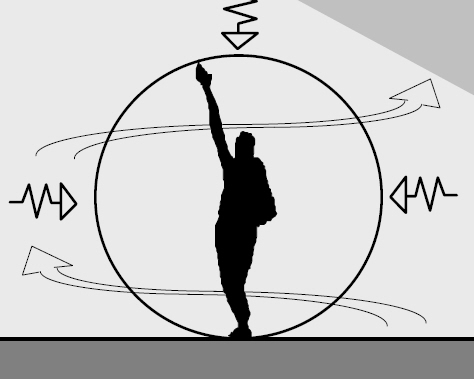Environment
Contents |
[edit] Introduction
In its broadest sense, the term ‘environment’ refers to all of the things around us. These things can affect our comfort, wellbeing, performance, behaviour, growth and development. In turn, our behaviour can impact on the environment around us.
In a very general way, the environment can be considered to comprise:
- The natural environment.
- The built environment.
[edit] The natural environment
The term 'natural environment' refers to the non-human-made surroundings and conditions in which all living and non-living things exist. The common concept of the natural environment encompasses two different components:
- Ecological units that operate as natural systems (such as soil, vegetation and so on).
- Universal natural resources (such as air and water).
In this sense, the term ‘environmental’ has become synonymous with ‘sustainability’ describing a desire to carry out activities without depleting resources or having harmful impacts, defined by the Brundtland Commission as 'meeting the needs of the present without compromising the ability of future generations to meet their own needs.' (ref. Brundtland Commission, Our Common Future, 1987).
For more information see: Natural environment.
[edit] The built environment
The term ‘built environment’ refers to aspects of our surroundings that are built by humans. It includes not only buildings, but the human-made spaces between buildings, such as parks, and the infrastructure that supports human activity such as transportation networks, utilities networks, flood defences, telecommunications, and so on.
The built environment is increasingly developed in a way that considers both its resilience to and its impact on the natural environment.
For more information see: Built environment.
[edit] Personal environmental conditions
The way that individuals experience the environment around them comprises a number of different characteristics, including:
- The thermal environment (air temperature, radiant temperature, air velocity and humidity).
- The visual environment (colour, views, lighting levels, glare, visual information and so on).
- The acoustic environment (sound and noise).
- Air quality (pollution, smells and so on)
- Textures.
[edit] Other classifications
Other definitions of the environment include:
- Internal environment.
- External environment.
- Historic environment.
- Ecological environment.
- Macro environment.
[edit] Business definition
The term 'environment' may also be used to describe the conditions within which a business operates. This can include the internal environment within the business itself, and the external environment outside the business that affects its activities. Typically the external environment is broken down into a micro environment and a macro environment.
The term 'environment' is also used in relation to computer coding to describe the development environment.
[edit] Related articles on Designing Buildings
- Air quality.
- Built environment.
- External environment.
- Historic environment.
- Indoor environmental quality.
- Internal environment.
- Operating environment.
- Macro environment.
- Micro environment.
- Natural environment.
- Sustainability.
- Thermal comfort.
- Thermal environment.
- Wellbeing.
- Environmental impact assessments.
Featured articles and news
Professional practical experience for Architects in training
The long process to transform the nature of education and professional practical experience in the Architecture profession following recent reports.
A people-first approach to retrofit
Moving away from the destructive paradigm of fabric-first.
International Electrician Day, 10 June 2025
Celebrating the role of electrical engineers from André-Marie Amperè, today and for the future.
New guide for clients launched at Houses of Parliament
'There has never been a more important time for clients to step up and ...ask the right questions'
The impact of recycled slate tiles
Innovation across the decades.
EPC changes for existing buildings
Changes and their context as the new RdSAP methodology comes into use from 15 June.
Skills England publishes Sector skills needs assessments
Priority areas relating to the built environment highlighted and described in brief.
BSRIA HVAC Market Watch - May 2025 Edition
Heat Pump Market Outlook: Policy, Performance & Refrigerant Trends for 2025–2028.
Committing to EDI in construction with CIOB
Built Environment professional bodies deepen commitment to EDI with two new signatories: CIAT and CICES.
Government Grenfell progress report at a glance
Line by line recomendation overview, with links to more details.
An engaging and lively review of his professional life.
Sustainable heating for listed buildings
A problem that needs to be approached intelligently.
50th Golden anniversary ECA Edmundson apprentice award
Deadline for entries has been extended to Friday 27 June, so don't miss out!
CIAT at the London Festival of Architecture
Designing for Everyone: Breaking Barriers in Inclusive Architecture.
Mixed reactions to apprenticeship and skills reform 2025
A 'welcome shift' for some and a 'backwards step' for others.






















